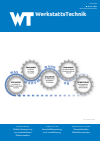wt Werkstattstechnik online
Zusammenfassung
In der Online-Zeitschrift für Forschung und Entwicklung in der Produktion – wt Werkstattstechnik online – werden die aktuellsten Forschungsergebnisse aus Wissenschaft, Technischer Hochschule und Industrie veröffentlicht - praxisbezogen und zukunftsorientiert. Die wt Werkstattstechnik online erscheint inklusive neun produktionsspezifischen Ausgaben pro Jahr unter der Internetadresse www.werkstattstechnik.de. Die in der wt Werkstattstechnik veröffentlichten Fachaufsätze sind wissenschaftlich-methodisch aufbereitet und grundsätzlich Erstveröffentlichungen. Viele Fachaufsätze sind peer-reviewed: von Experten auf diesem Gebiet – anonym sowie unabhängig von den Autoren – wissenschaftlich begutachtet und freigegeben. Die wt Werkstattstechnik online ist Organ der VDI-Gesellschaft Produktion und Logistik (GPL) sowie der wissenschaftlichen Gesellschaft für Produktionstechnik (WGP).
- 1–5 Titelei/Inhaltsverzeichnis 1–5
- 2–54 Titelthema Aufsatz 2–54
- 2–8 Benchmark von Lastprognosemethoden/Comparing forecasting methods systematically 2–8
- 9–15 Energieflexibler Kältedemonstrator/Energy flexible refrigeration demonstrator 9–15
- 16–21 Effiziente Trocknung mit Induktion und Infrarot/Efficient drying with induction and infrared – Savings potential of alternative drying technologies for energy-efficient parts drying 16–21
- 22–27 Hämmerndes Drehen/Hammering turning – main time parallel cutting and mechanical surface texturing 22–27
- 28–33 Erhöhte Haftfestigkeit thermischer Spritzschichten/Increased adhesion of thermal sprayed coatings – Innovative process combination enables substitution of conventional blasting processes 28–33
- 34–38 Methoden zur defektfreien Zerspanung von Silizium/New research approach through adapted tool paths – Methods for flawless machining of silicon 34–38
- 39–43 Ultraschallunterstützte Funkenerosion/Electrical discharge machining of dental implants in ultrasonic stimulated dielectric 39–43
- 44–49 Effizientes Schmieren der Spanbildungszone/Controlled use of cooling lubricants for tribological optimization of machining processes – Efficient lubrication of the chip formation zone 44–49
- 50–54 Visualisierung der Spanbildung beim Sägen mit IKZ/Visualisation of chip formation during sawing with ICS – Chip formation in the closed cutting gap when sawing with internal cooling lubricant supply 50–54
- 55–60 Aufsatz 55–60
- Sensorbasierte Montageanalyse/Transparency in manual assembly processes – Sensor-based assembly analysis
- 61–88 Titelthema Aufsatz 61–88
- 61–66 Spanntechnik beim Absägen von AM-Bauteilen/Clamping system for sawing AM components 61–66
- 67–72 Einsatzpotenzial von MMS in der Holzbearbeitung/Influence of minimum quantity lubrication on surface quality during circular sawing of wood 67–72
- 73–78 Verschleißbewertung und -modellierung/Milling of titanium aerostructures using solid cemented carbide tools - Evaluation and modelling of tool wear 73–78
- 79–83 Schwingungsanalyse an Tieflochbohrwerkzeugen/Vibration analysis of deep hole drilling tools - Experimental analysis of lateral vibrations of deep-hole drilling tools and development of a testing rig 79–83
- 84–88 Datengetriebene Qualitätsüberwachung beim Reiben/Data-driven quality monitoring in reaming 84–88
- 89–90 Titelthema Fraunhofer 89–90
- Wie überwache und prognostiziere ich den Abnutzungsvorrat?
- 91–102 Titelthema Aufsatz 91–102
- 91–96 Anwendungen und Geschäftsmodelle mit Gaia-X/Applications and business models with Gaia-X – EuProGiant – From use case to business case with Gaia-X in the Industrie 4.0 domain 91–96
- 97–102 Energieeffizienz in der Produktion umsetzen/Implementing energy efficiency measures in industrial production – Motivating factors and implementation barriers from the ETA-Transfer project 97–102
- 103–106 Titelthema BMBF 103–106
- MIM – höhere Oberflächengüte bei geringeren Rohstoffkosten/Improved titanium-based injection molded parts through post-processing to reduce O2 content. MIM – higher surface quality with lower raw material costs


